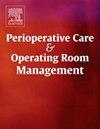Improving the safety patient and quality of care of the totally implantable venous access device process in oncology: An experience in a developing country tertiary university hospital
IF 1
Q2 Nursing
Perioperative Care and Operating Room Management
Pub Date : 2025-03-19
DOI:10.1016/j.pcorm.2025.100484
引用次数: 0
Abstract
Background
The totally implantable venous access device, named also the implantable chamber, is one of the most medical devices used in the oncological therapies. However, the process of implementing such devices provide several failure modes which decrease the quality of care and the enhance the risk of patient complications. For this reason, it is essential to develop an effective risk management plan enable to detect and reduce different associated risks in order to improve the quality and the safety processes in the totally implantable venous access device implementation activity.
Methods
The process of identification and assessment of risks is ensured using an adapted Failure Modes and Effects Analysis (FMEA) to the context of developing countries (application field is a Moroccan oncology university centre). Finally, the prioritization of corrective actions is calculated based on a proposed parameter (named the Priority Level) which takes into consideration developing countries constraints.
Results
The study of the totally implantable venous access device process leads to identify a large number of potential failures (n=72) which are divided in 3 classes (19 % intolerable, 51 % to be monitored; and 29 % of intolerable). Moreover, the adapted approach of FMEA proves high optimization of the project in terms of time and resources. An action program mapping is developed in order based on the Rik Priority Number and the Priority Level.
Conclusion
The implantable chamber poses a major challenge to any practitioner in oncology. This study constitutes the first experience in risk management of implantable chambers under developing countries constraints while highlighting all the failures to be prevented during their handling.
提高肿瘤全植入式静脉通路装置过程的安全性和护理质量:发展中国家三级大学医院的经验
全植入式静脉通路装置又称植入式腔室,是肿瘤治疗中应用最多的医疗器械之一。然而,实施这些装置的过程提供了几种失效模式,降低了护理质量并增加了患者并发症的风险。因此,必须制定有效的风险管理计划,以发现和减少各种相关风险,以提高全植入式静脉通路装置实施活动的质量和安全过程。方法使用适应发展中国家背景的失效模式和影响分析(FMEA)确保识别和评估风险的过程(应用领域是摩洛哥肿瘤大学中心)。最后,根据建议的参数(称为优先级)计算纠正行动的优先次序,该参数考虑到发展中国家的限制。结果通过对全植入式静脉通路装置过程的研究,发现了大量的潜在故障(n=72),分为3类(19%不可容忍,51%需要监测;29%的人无法忍受)。此外,FMEA的自适应方法证明了项目在时间和资源方面的高度优化。根据Rik优先编号和优先级别,制定了行动方案图。结论植入式腔室对任何肿瘤学从业者都是一个重大挑战。本研究构成了在发展中国家限制下植入式腔室风险管理的第一个经验,同时强调了在处理过程中要防止的所有失败。
本文章由计算机程序翻译,如有差异,请以英文原文为准。
求助全文
约1分钟内获得全文
求助全文
来源期刊

Perioperative Care and Operating Room Management
Nursing-Medical and Surgical Nursing
CiteScore
1.30
自引率
0.00%
发文量
52
审稿时长
56 days
期刊介绍:
The objective of this new online journal is to serve as a multidisciplinary, peer-reviewed source of information related to the administrative, economic, operational, safety, and quality aspects of the ambulatory and in-patient operating room and interventional procedural processes. The journal will provide high-quality information and research findings on operational and system-based approaches to ensure safe, coordinated, and high-value periprocedural care. With the current focus on value in health care it is essential that there is a venue for researchers to publish articles on quality improvement process initiatives, process flow modeling, information management, efficient design, cost improvement, use of novel technologies, and management.
 求助内容:
求助内容: 应助结果提醒方式:
应助结果提醒方式:


